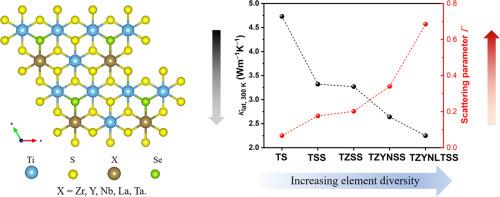当前位置:
X-MOL 学术
›
Acta Mater.
›
论文详情
Our official English website, www.x-mol.net, welcomes your
feedback! (Note: you will need to create a separate account there.)
Achieving low thermal conductivity and high quality factor in sextuple-doped TiS2
Acta Materialia ( IF 8.3 ) Pub Date : 2024-11-06 , DOI: 10.1016/j.actamat.2024.120548 Jinxue Ding, Wei Li, Moritz Thiem, Konstantin P. Skokov, Nina Kintop, Anke Weidenkaff, Wenjie Xie
Acta Materialia ( IF 8.3 ) Pub Date : 2024-11-06 , DOI: 10.1016/j.actamat.2024.120548 Jinxue Ding, Wei Li, Moritz Thiem, Konstantin P. Skokov, Nina Kintop, Anke Weidenkaff, Wenjie Xie

|
Transition-metal dichalcogenide TiS2 stands out as a sustainable candidate for room- and medium-temperature thermoelectric materials due to its affordability, non-toxicity, eco-friendly nature and use of non-critical elements. However, its light element compositional nature results in a large thermal conductivity, which is the main limitation of the thermoelectric performance of TiS2 . Here, we report a multi-element doping strategy by incorporating equivalent (Se, Zr) elements and introducing higher-valence (Nb, Ta) and lower-valence (Y, La) elements in pairs to minimize its lattice thermal conductivity, κ lat κ lat κ lat 2 , as point defects can effectively scatter phonons at room temperature. As a result, the multi-element doped TiS2 attained its highest ZT value of approximately 0.4 at 625 K. Incorporating higher-valence and lower-valence elements in pairs proves to be an effective method for decreasing lattice thermal conductivity without compromising too much of its large Seebeck coefficient.
中文翻译:

在六元组掺杂 TiS2 中实现低热导率和高品质因数
过渡金属二硫化物 TiS2 因其经济性、无毒、环保性和使用非关键元素而成为室温和中温热电材料的可持续候选者。然而,它的轻元素组成性质导致较大的热导率,这是 TiS2 热电性能的主要限制。在这里,我们报告了一种多元素掺杂策略,通过掺入等效 (Se, Zr) 元素并成对引入高价 (Nb, Ta) 和低价 (Y, La) 元素,以最小化其晶格热导率 κlat。研究结果表明,在整个温度范围内,κlat 减少了近 50%,这归因于多元素掺杂后存在强烈的点缺陷散射。此外,我们观察到多元素掺杂的 TiS2 中 κlat 对温度的依赖性降低,因为点缺陷可以在室温下有效地散射声子。结果,多元素掺杂的 TiS2 在 625 K 时达到了最高的 ZT 值,约为 0.4。事实证明,将高价元素和低价元素成对结合是降低晶格热导率的有效方法,而不会过多地损害其较大的塞贝克系数。
更新日期:2024-11-06
中文翻译:

在六元组掺杂 TiS2 中实现低热导率和高品质因数
过渡金属二硫化物 TiS2 因其经济性、无毒、环保性和使用非关键元素而成为室温和中温热电材料的可持续候选者。然而,它的轻元素组成性质导致较大的热导率,这是 TiS2 热电性能的主要限制。在这里,我们报告了一种多元素掺杂策略,通过掺入等效 (Se, Zr) 元素并成对引入高价 (Nb, Ta) 和低价 (Y, La) 元素,以最小化其晶格热导率 κlat。研究结果表明,在整个温度范围内,κlat 减少了近 50%,这归因于多元素掺杂后存在强烈的点缺陷散射。此外,我们观察到多元素掺杂的 TiS2 中 κlat 对温度的依赖性降低,因为点缺陷可以在室温下有效地散射声子。结果,多元素掺杂的 TiS2 在 625 K 时达到了最高的 ZT 值,约为 0.4。事实证明,将高价元素和低价元素成对结合是降低晶格热导率的有效方法,而不会过多地损害其较大的塞贝克系数。


















































 京公网安备 11010802027423号
京公网安备 11010802027423号